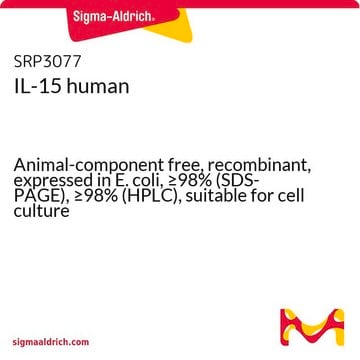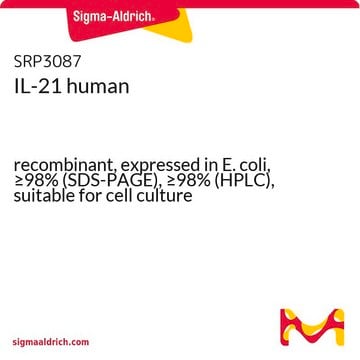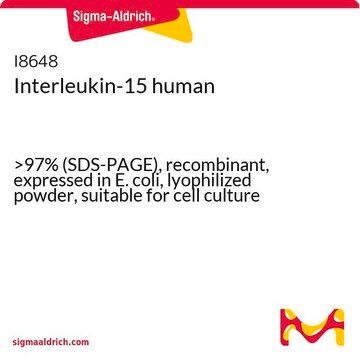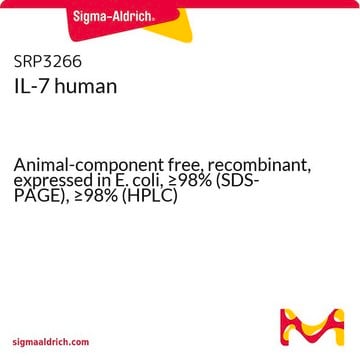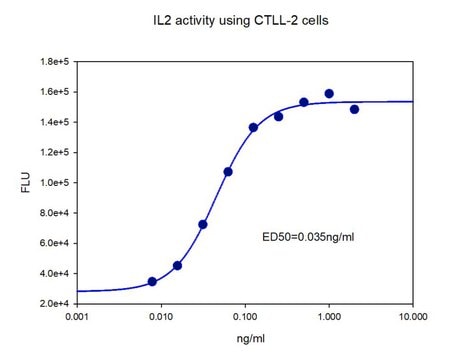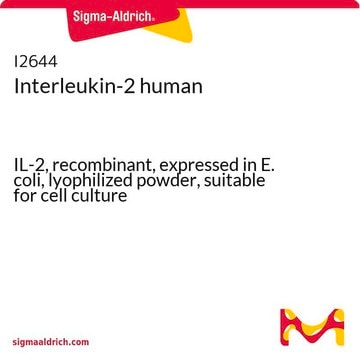SRP3088
IL-21 human
Animal-component free, recombinant, expressed in E. coli, ≥98% (SDS-PAGE), ≥98% (HPLC), suitable for cell culture
Sign Into View Organizational & Contract Pricing
All Photos(1)
About This Item
UNSPSC Code:
12352202
NACRES:
NA.32
Recommended Products
biological source
human
recombinant
expressed in E. coli
Assay
≥98% (HPLC)
≥98% (SDS-PAGE)
form
lyophilized
mol wt
15.0 kDa
packaging
pkg of 10 μg
technique(s)
cell culture | mammalian: suitable
impurities
<0.1 EU/μg endotoxin, tested
color
white to off-white
UniProt accession no.
shipped in
wet ice
storage temp.
−20°C
Gene Information
human ... IL21(59067)
General description
IL-21 is a pleiotropic cytokine produced by CD4+ T cells in response to antigenic stimulation. Its action generally enhances antigen-specific responses of immune cells. The biological effects of IL-21 include induction of differentiation of T-cells-stimulated B-cells into plasma cells and memory B-cells, stimulation (in conjunction) with IL-4 of IgG production, and induction of apoptotic effects in naïve B-cells and stimulated B-cells in the absence of T-cell signaling. Additionally, IL-21 promotes the anti-tumor activity of CD8+ T-cells and NK cells. IL-21 exerts its effect through binding to a specific type I cytokine receptor, IL-21R, which also contains the gamma chain (gc) found in other cytokine receptors including IL-2, IL-4, IL-7, IL-9 and IL-15. The IL-21/IL-21R interaction triggers a cascade of events which includes activation of the tyrosine kinases JAK1 and JAK3, followed by activation of the transcription factors STAT1 and STAT3. Recombinant human IL-21 is a 15.0 kDa protein consisting of 132 amino acid residues.
Biochem/physiol Actions
IL-21 is a pleiotropic cytokine produced by CD4+ T cells in response to antigenic stimulation. Recombinant human IL-21 is a 15.0 kDa protein consisting of 132 amino acid residues.
Sequence
MQDRHMIRMR QLIDIVDQLK NYVNDLVPEF LPAPEDVETN CEWSAFSCFQ KAQLKSANTG NNERIINVSI KKLKRKPPST NAGRRQKHRL TCPSCDSYEK KPPKEFLERF KSLLQKMIHQ HLSSRTHGSE DS
Physical form
Lyophilized from 10 mM Sodium Phosphate, pH 7.6.
Reconstitution
Centrifuge the vial prior to opening. Reconstitute in water to a concentration of 0.1-1.0 mg/ml. Do not vortex. This solution can be stored at 2-8°C for up to 1 week. For extended storage, it is recommended to further dilute in a buffer containing a stabilizer (example 5% Trehalose) and store in working aliquots at -20°C to -80°C.
Storage Class Code
11 - Combustible Solids
WGK
WGK 3
Flash Point(F)
Not applicable
Flash Point(C)
Not applicable
Certificates of Analysis (COA)
Search for Certificates of Analysis (COA) by entering the products Lot/Batch Number. Lot and Batch Numbers can be found on a product’s label following the words ‘Lot’ or ‘Batch’.
Already Own This Product?
Find documentation for the products that you have recently purchased in the Document Library.
Julia Parrish-Novak et al.
Journal of leukocyte biology, 72(5), 856-863 (2002-11-14)
Interleukin (IL)-21 was recently discovered using a functional cloning approach based on expression of its receptor. It is similar in domain organization and primary sequence to IL-2 and IL-15. Like these cytokines, IL-21 uses the common gamma chain of the
Jennifer Lee et al.
Immunology, 142(4), 573-580 (2014-02-06)
Systemic lupus erythematosus (SLE) is an autoimmune disease in which abnormal immune responses are mediated by tissue-binding autoantibodies and immune complex deposition. Because most SLE patients are women of child-bearing age, oestrogen has been suggested to play an important role
Iskra Tuero et al.
PLoS pathogens, 11(8), e1005101-e1005101 (2015-08-13)
Many viral infections, including HIV, exhibit sex-based pathogenic differences. However, few studies have examined vaccine-related sex differences. We compared immunogenicity and protective efficacy of monomeric SIV gp120 with oligomeric SIV gp140 in a pre-clinical rhesus macaque study and explored a
Melinda Mata et al.
Journal of immunotherapy (Hagerstown, Md. : 1997), 37(8), 407-415 (2014-09-10)
Adoptive transfer of T cells expressing chimeric antigen receptors (CARs) has shown promising antitumor activity in early phase clinical studies, especially for hematological malignancies. However, most preclinical models do not reliably mimic human disease. We reasoned that developing an adoptive
Elisabeth Salzer et al.
The Journal of allergy and clinical immunology, 133(6), 1651-1659 (2014-04-22)
Alterations of immune homeostasis in the gut can result in development of inflammatory bowel disease (IBD). Recently, Mendelian forms of IBD have been discovered, as exemplified by deficiency of IL-10 or its receptor subunits. In addition, other types of primary
Our team of scientists has experience in all areas of research including Life Science, Material Science, Chemical Synthesis, Chromatography, Analytical and many others.
Contact Technical Service